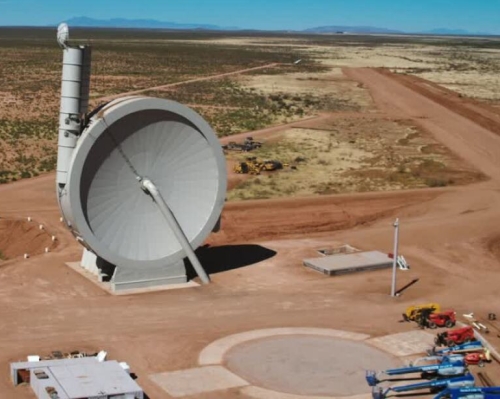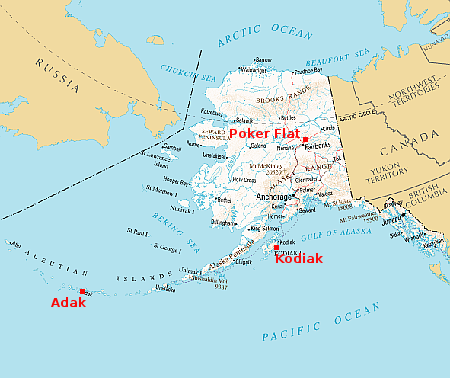Spinlaunch signs deal to build its spin launch facility on island in Alaska

Spinlaunch has now confirmed that it has signed a deal to build its spin launch facility on Adak island in the far western extent of the Alaskan island chain.
The facility will be a scaled up version of its spin launch test facility in New Mexico, shown to the right, that was used for tests back in 2022, hurling payloads 35,000 feet into the sky up by spinning them up.
Since then the company changed its leadership and shifted focus to building a satellite constellation that will at least initially will be launched by conventional rockets. This new agreement, actually signed in October 2024 but kept secret until now, suggests that it has not yet abandoned its spin launch technology.

Location of Spinlaunch’s proposed Adak launch site.
Kodiak and Poker Flat are Alaska’s other launch sites.
This launch site, marked as Adak on the map to the right, has a great deal of spaceport potential, even if Spinlaunch doesn’t end up building a spinner there for launching payloads.
All that being said, it seems they finally found the right spot, with agreement said to be a 100-year lease. The small island features multiple benefits that the company had been looking for. The first is its location, which provides plenty of launch trajectories over the Pacific Ocean. Also, the island, despite its small size and population of around 50, has an operational airport with scheduled passenger service and a deepwater port. Lastly, the company highlighted that infrastructure from a former Naval Air Facility on the island can be repurposed to support space operations, reducing development time and costs.
We therefore should not be surprised if down the road Spinlaunch continues its shift away from spinning payloads into space and instead eventually becomes a spaceport provider to other rocket companies.
Hat tip to BtB’s stringer Jay.
On Christmas Eve 1968 three Americans became the first humans to visit another world. What they did to celebrate was unexpected and profound, and will be remembered throughout all human history. Genesis: the Story of Apollo 8, Robert Zimmerman's classic history of humanity's first journey to another world, tells that story, and it is now available as both an ebook and an audiobook, both with a foreword by Valerie Anders and a new introduction by Robert Zimmerman.
The print edition can be purchased at Amazon or from any other book seller. If you want an autographed copy the price is $60 for the hardback and $45 for the paperback, plus $8 shipping for each. Go here for purchasing details. The ebook is available everywhere for $5.99 (before discount) at amazon, or direct from my ebook publisher, ebookit. If you buy it from ebookit you don't support the big tech companies and the author gets a bigger cut much sooner.
The audiobook is also available at all these vendors, and is also free with a 30-day trial membership to Audible.
"Not simply about one mission, [Genesis] is also the history of America's quest for the moon... Zimmerman has done a masterful job of tying disparate events together into a solid account of one of America's greatest human triumphs."--San Antonio Express-News

Spinlaunch has now confirmed that it has signed a deal to build its spin launch facility on Adak island in the far western extent of the Alaskan island chain.
The facility will be a scaled up version of its spin launch test facility in New Mexico, shown to the right, that was used for tests back in 2022, hurling payloads 35,000 feet into the sky up by spinning them up.
Since then the company changed its leadership and shifted focus to building a satellite constellation that will at least initially will be launched by conventional rockets. This new agreement, actually signed in October 2024 but kept secret until now, suggests that it has not yet abandoned its spin launch technology.

Location of Spinlaunch’s proposed Adak launch site.
Kodiak and Poker Flat are Alaska’s other launch sites.
This launch site, marked as Adak on the map to the right, has a great deal of spaceport potential, even if Spinlaunch doesn’t end up building a spinner there for launching payloads.
All that being said, it seems they finally found the right spot, with agreement said to be a 100-year lease. The small island features multiple benefits that the company had been looking for. The first is its location, which provides plenty of launch trajectories over the Pacific Ocean. Also, the island, despite its small size and population of around 50, has an operational airport with scheduled passenger service and a deepwater port. Lastly, the company highlighted that infrastructure from a former Naval Air Facility on the island can be repurposed to support space operations, reducing development time and costs.
We therefore should not be surprised if down the road Spinlaunch continues its shift away from spinning payloads into space and instead eventually becomes a spaceport provider to other rocket companies.
Hat tip to BtB’s stringer Jay.
On Christmas Eve 1968 three Americans became the first humans to visit another world. What they did to celebrate was unexpected and profound, and will be remembered throughout all human history. Genesis: the Story of Apollo 8, Robert Zimmerman's classic history of humanity's first journey to another world, tells that story, and it is now available as both an ebook and an audiobook, both with a foreword by Valerie Anders and a new introduction by Robert Zimmerman.
The print edition can be purchased at Amazon or from any other book seller. If you want an autographed copy the price is $60 for the hardback and $45 for the paperback, plus $8 shipping for each. Go here for purchasing details. The ebook is available everywhere for $5.99 (before discount) at amazon, or direct from my ebook publisher, ebookit. If you buy it from ebookit you don't support the big tech companies and the author gets a bigger cut much sooner.
The audiobook is also available at all these vendors, and is also free with a 30-day trial membership to Audible.
"Not simply about one mission, [Genesis] is also the history of America's quest for the moon... Zimmerman has done a masterful job of tying disparate events together into a solid account of one of America's greatest human triumphs."--San Antonio Express-News


I’ve always thought the spin launch concept was interesting. But it strikes me that the stresses required to ‘spin’ something into LOE are just prohibitive. If you wanted to launch a brick, that’s fine, but could a solar panel, for example, survive the stresses of the spin? The g-forces required to accelerate to an orbital velocity would be significant.
What I want to know is how will they get the lateral velocity to enter orbit once they leave the atmosphere?
Edward KK,
SpinLaunch is interesting technology but not especially well-suited for Earth departures. It would be ideal for yeeting bulk commodity payloads into orbit from the Moon without requiring any propellant, being much more compact than notional O’Neillian linear mass drivers. I hope the company’s diversifications allow it to stay in business long enough to establish itself in the coming cis-lunar industrial economy. The technology might well be practical for Mars too.
Digital Night,
The centrifuge is only the equivalent of a first stage in terms of imparting orbital energy. What would actually be spin-launched would be the equivalent of rocket upper stages that would handle the rest of the job of getting highly G-tolerant payloads into orbit. The rockets, of course, would also be engineered to be highly G-tolerant.
As I noted above, this technology seems a rather poor fit for Earth-origin launches but would be ideal for the Moon and probably workable on Mars as well.
I think rather more of Longshot’s attempt at a Verne gun.
This technology might make an interesting weapon. A modern day trebuchet, capable of dropping mass onto targets with minimal cost. There’s probably a science fiction story where this idea is referenced, all due consideration to Verne.
Jeff Wright,
Impey Barbicane and the Baltimore Gun Club, eh? The only “Longshot” I’m familiar with was a notion from the 80s about a probe to Proxima Centauri, but that didn’t involve a giant gun so far as I know. Do you have a link to anything about the “Longshot” you’ve referenced?
jburn,
Interesting idea. Not sure what the maximum strictly ballistic range would be but then the plan is to use rockets to complete the trip to orbit so the same could be easily done to extend the range of suborbital ammunition payloads. I suspect the rate of fire would not be particularly impressive though.
Dick Eagleson,
I agree it’s a much more likely solution for a low gravity situation. But that implementation would be several years, if not decades, down the road. And I’m not sure those solutions are cost effective. having 2 different launch solutions available for something like Lunar launches would add complexity to the equation when I’m not sure it adds a lot of value.
I love the testing and validation of concept. I worry for the company as I don’t see this as a viable business model for quite a while if ever. it’s good they are looking for other solutions to fund the company until they find something this can work with.
Now, if we can find a way to leverage this to throw materials that can handle the stresses into orbit in parallel to standard launch solutions – that might be very interesting. For example, imagine if we can throw fuel to reload something like a starship. Or water for human use in space.